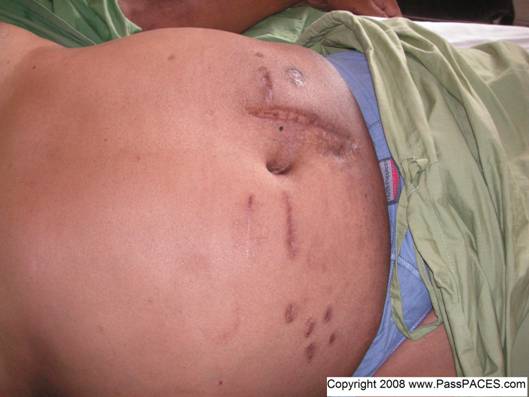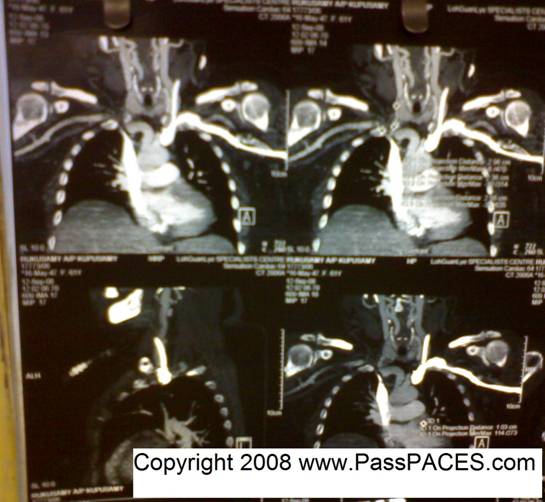
|
|
|||||
|
|
|
|
|
|
|
YOUR LATEST ISSUE ABOUT MRCP PACES IS HERE!
Examine this gentleman abdominal system .

Discussion:
I think this case is an easy case for everyone. If you do not miss the scar, you are going to diagnose the case after inspection. This gentleman has previous CAPD but removed after a successful kidney transplant. If you pull down his underwear, you will notice a oblique scar over his right inguinal region. If you proceed further, you can find a vague mass underlying the scar and it is dull on percussion.
However, for you to pass your MRCP PACES, you need to answer the following questions,
1) Is the kidney graft still functioning?
2) Does the patient develop any complications after the kidney transplantation?
3) What is the most likely cause for this patient's end stage renal failure?
As I said in my earlier issues, there are a few ways you can suggest to the examiners that might give you clues about the graft functions. You may want to look at whether the patient is still dependent on dialysis. ( Any Tenckoff catheter? Any recent puncture wound at the functioning fistula?) You can suggest to examiners that you want to measure patient's 24 hour urine output as well.
As for the complications, I always look for common complications after transplantations such as 1) Side effects of the drugs- especially calcineurin inhibitors such as cyclosporin such as tremor, gum hypertrophy and hypertrichosis (or hirsutism). I also always look for end organ damage of diabetes mellitus especially diabetic retinopathy because immunosuppressants can cause diabetes and diabetes itself is one of the leading causes of ESRF in this part of the world ( Malaysia and Singapore). 2) Malignancy- I always look hard for skin cancer. My friend failed this station because he missed skin squamous cell cancer during his MRCP PACES last year. Also look hard for lymphoma! 3) Infections- This is always the main reason a transplant patient is admitted to hospital- I always suggest to examiners I would like to look at the temperature chart!
If possible, I would like to find out the underlying cause for the patient's ESRF- I always think the easiest causes you can find in your MRCP PACES are diabetes mellitus ( you may find a lot of end organ damage of diabetes in your patient), gout with NSAID ( you might see a lot of gout tophi) and SLE ( a young lady- you can suggest to examiners that you think it is the most likely cause!)
Common questions examiners would ask you
![]() 1) What are contraindications for a kidney transplantation? ( what disease has a recurrance rate of almost 100% after transplantation?)
1) What are contraindications for a kidney transplantation? ( what disease has a recurrance rate of almost 100% after transplantation?)
![]() 2) What do you mean by hypertrichosis, hirsutism and virilisim?
2) What do you mean by hypertrichosis, hirsutism and virilisim?
![]() 3) What classes of immunosuppressant being used in kidney transplantation?
3) What classes of immunosuppressant being used in kidney transplantation?
Diagnosis: This gentleman has kidney transplantation.
Extra points:
| ID:2 | Created: 4 Oct 2008 |
Interesting Images in Clinical Medicine.

Case History:
Ms Ruku is a 45-year old Indian lady with ESRF on haemodialysis presented to our hospital with left upper limb swelling. Please describe the CT venogram scan shown above. What is the abnormality and what is the probable diagnosis??
To see previous issues, click here! To send a quick comment, click here!